
News & announcements!
Saving your history
Early accounts
Maps
Nearby towns
People
Churches
Schools
Municipal
Organizations
Businesses
The mines
Transportation
Streets
Buildings
Entertainment
Celebrations
Sports
Ethnic groups
Past featured photos, page 2
Here are links to three pages containing previously posted photos and information from the Featured Photos section of the home page: earliest postings, more recent ones, and the most recent ones. They are credited to the sources.
Note: The featured photos listed immediately below have been relocated elsewhere on the website. The others further down on the page will be relocated once I make new places for them.
Highland views from yesteryear, from Tom Yaruso - originally posted October 1, 2014 - now at http://www.andrew.cmu.edu/user/ct0u/ty-highland-views.html
St. Casimir's Communion class 1914, from Tom Yaruso - originally posted December 26, 2016 - now at http://www.andrew.cmu.edu/user/ct0u/stcasimirs.html
Upper Lehigh honor rolls, from Nadine Heckler - originally posted December 26, 2016 - now at http://www.andrew.cmu.edu/user/ct0u/upperlehigh-honor-roll.html
Upper Lehigh school, from Nadine Heckler - originally posted December 26, 2016 - now at http://www.andrew.cmu.edu/user/ct0u/upperlehigh.html
School children, public school on School St. just west of Vine St., early 1900s, from Nadine Heckler - originally posted December 26, 2016 - now at http://www.andrew.cmu.edu/user/ct0u/frldstudentpics.html
A mystery bar on Main Street in Freeland, still to be identified - originally posted December 26, 2016 - now at http://www.andrew.cmu.edu/user/ct0u/frldsaloons.html
Gabuzda brothers’ grocery stores in Freeland, from - originally posted March 4, 2016 - now at http://www.andrew.cmu.edu/user/ct0u/gabuzda.html
Remak grocery and bar businesses in Freeland - originally posted March 4, 2016 - now at http://www.andrew.cmu.edu/user/ct0u/remak.html
Merrick grocery stores in Freeland - originally posted March 4, 2016 - now at http://www.andrew.cmu.edu/user/ct0u/merrick.html
Gubi from St. Mary's church in Freeland, from Ann Malenky Nakpairat - originally posted June 18, 2010 and reposted December 25, 2015 - now at http://www.andrew.cmu.edu/user/ct0u/stmarys-gubi.html
St. Ann's in Woodside, a century or more ago, from Charlie Gallagher - originally posted August 18, 2015 - now at http://www.andrew.cmu.edu/user/ct0u/stanns-woodside.html
Early views of St. Mary's Byzantine Catholic Church - originally posted March 20, 2015 - now at http://www.andrew.cmu.edu/user/ct0u/stmarys-early.html
An interior view of an early Freeland factory, from Judy Domchick Hall - originally posted November 19, 2013 - now at http:// www.andrew.cmu.edu/user/ct0u/frldfactory-1914.html
Do these young people look familiar? From Veronica Heston - originally posted August 10, 2014 - now at <a href="two-frld-irish-to-identify.html">http://www.andrew.cmu.edu/user/ct0u/two-frld-irish-to-identify.html</a>
Note: For more recently received corrections or added information, search for double asterisks ** and maroon-colored headings.
New photos from Ed Merrick, Charlie Gallagher, Diane Unangst,
Nadine Heckler - Happy New Year! More information from all
of these folks was added 1-14-17 to update the text.
Posted Dec. 26, 2016 and Jan. 14, 2017:
- Mike Remak's pine tree - updated 2-5-17; correction about Boyle's gas station
- St. Casimir's Communion class 1914 or 1918 - updated 1-14-17
- Cross made from old organ of St. John's Reformed Church - updated 1-14-17
- Merkt Hotel - updated 1-14-17
- Upper Lehigh honor rolls and school - updated 1-14-17
- School children, public school on School St. just west of Vine St., early 1900s - updated 1-14-17
- Freeland Overall Factory patent for trademark, plus a note
on Thomas Oberrender
- John Ricotta in WWI
- 1888 map of the coal fields in the Beaver Meadow and Druck
Creek basins
- A bar on Main Street in Freeland, still to be identified - updated 1-14-17
I have been remiss in getting my website updated, so here is a group of new images from some of our historical contributors who are kind enough to share these with everyone. Thank you, Ed, Charlie, Diane, Nadine and Tom!
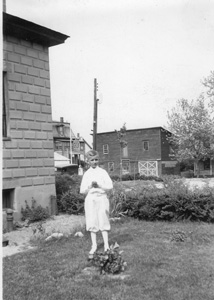
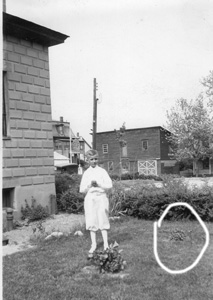
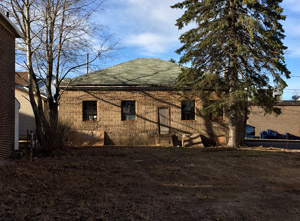 Mike Remak's pine tree, from Ed Merrick: "The modern
photo of my grandfather's [Mike Remak's] garage with the giant tree
(Norfolk pine?) in front intrigued me. I have attached a photo that was
taken in 1940 of my brother on his confirmation day in 1940 in my
grandparents' backyard. Note the tiny tree. My brother and I had a game
for years of jumping over it. I think it's the same tree."
Mike Remak's pine tree, from Ed Merrick: "The modern
photo of my grandfather's [Mike Remak's] garage with the giant tree
(Norfolk pine?) in front intrigued me. I have attached a photo that was
taken in 1940 of my brother on his confirmation day in 1940 in my
grandparents' backyard. Note the tiny tree. My brother and I had a game
for years of jumping over it. I think it's the same tree."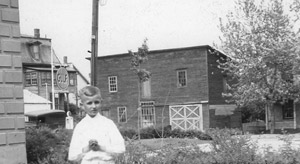 I asked Ed if he
could identify the buildings in the background, enlarged here. He
wrote: "The building on the left (southeast corner of Front and
Washington) is the one that housed Lindsay's hardware store on the
ground floor. The building to the right was a garage that may also have
been owned by the Lindsays. I don't remember that service station, but
I do remember going into Lindsay's with my Dad to buy, say, 5 pounds of
10-penny nails, scooping them out of a keg, and putting them into a
paper bag, which promptly sprouted like a porcupine from the nail tips
puncturing the sack."
I asked Ed if he
could identify the buildings in the background, enlarged here. He
wrote: "The building on the left (southeast corner of Front and
Washington) is the one that housed Lindsay's hardware store on the
ground floor. The building to the right was a garage that may also have
been owned by the Lindsays. I don't remember that service station, but
I do remember going into Lindsay's with my Dad to buy, say, 5 pounds of
10-penny nails, scooping them out of a keg, and putting them into a
paper bag, which promptly sprouted like a porcupine from the nail tips
puncturing the sack." Does anyone know whose garage that would have been behind Lindsay's?
Well, I asked that question and got email from Charlie Gallagher, who found some newspaper ads from the 1950s: "Boyle's Gulf Station Washington St., Freeland, Next to the A&P." Charlie and I were speculating on the possibility of a Brogan-Boyle marital connection through Mary Brogan, because I saw that in the 1940 city directory there's this listing: Brogan Peter A. gasoline 614 Washn r 1155 Schwabe, and Charlie had seen some information online about a Mary Brogan having married a Boyle.
Ed Merrick wrote to say: "The 1954 Minamek has an ad for Hugh Boyle's Service Station, Washington Street, Freeland. No street number is included."
Then Sandie Bredbenner wrote on facebook to say: "Good Morning, I'm new to this page, my maiden name is Sandie Stower. I lived on Schwabe St. next to the Brogan family home which was a summer home during my childhood. Peter Brogan's garage was not taken over by his sister Mary Boyle's husband. It was a different Boyle. Mary (Brogan) Boyle's husband was John and he was associated with Haze Drug in Hazleton and they lived in Hazeton. The Brogans were Sarah, Peter, Mary, Bill and Pauline."
So now I'm reporting that while that gas station was listed as being run by Peter Brogan in 1940, by 1954 it was run by Hugh Boyle. If anyone can contribute more information about these businesses and/or their owners, I'd be grateful and would be glad to post it here.
I'll add that the ealier Sanborn maps show a livery stable in that spot, and the 1921-22 city directory has a listing for a livery owned by "Cologno, Emilio – Washington cor Main." Does anyone know anything about this man or his business?
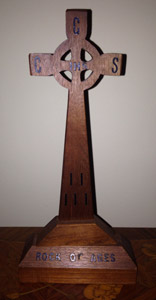

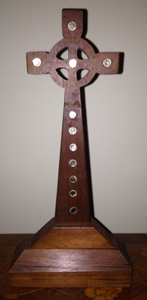 Cross made from old organ of St.
John's Reformed Church, from Diane Unangst: "I have been
enjoying your History of Freeland website. I am a descendent of
Freeland folks: my parents, grandparents and many of my
great-grandparents. My parents and all grandparents were married in the
St Johns Reformed Church. My Aunt (Mary Ellen Van Horn) played the
organ there for many years. When they replaced the old church with the
new one in 1934 they also replaced the organ. Reverend Kohler had them
take the old organ and make wooden crosses out of it, and I have one of
them which my maternal grandmother gave me. Attached is a photo of it.
Don't know how unique it is because there may be many Freeland folks
who also have one." Does anyone else who is reading this know
of others who own one of these crosses?
Cross made from old organ of St.
John's Reformed Church, from Diane Unangst: "I have been
enjoying your History of Freeland website. I am a descendent of
Freeland folks: my parents, grandparents and many of my
great-grandparents. My parents and all grandparents were married in the
St Johns Reformed Church. My Aunt (Mary Ellen Van Horn) played the
organ there for many years. When they replaced the old church with the
new one in 1934 they also replaced the organ. Reverend Kohler had them
take the old organ and make wooden crosses out of it, and I have one of
them which my maternal grandmother gave me. Attached is a photo of it.
Don't know how unique it is because there may be many Freeland folks
who also have one." Does anyone else who is reading this know
of others who own one of these crosses?My brother Steve looked at the photo of the back of the wooden cross made from the old St. John's Reformed organ and said that those dots are probably made from the pearlized organ stops, probably abalone shell.
Charlie Gallagher adds this memory: "Reverend Kohler was a great wood carver.
A lot of folks don’t remember, but he carved and modeled old wood sailing ships throughout most of his life. His miniature ships were done to perfection with all the fabric sails and all the associated rigging. Hours and hours of meticulous work requiring a lot of pre planning and patience. He was a true craftsman."
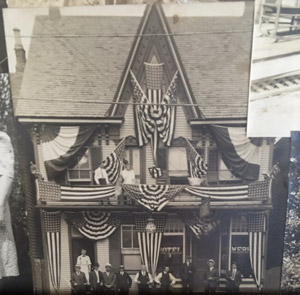 Merkt Hotel, from
Diane Unangst: Clara Maso provided this photo of the Merkt Hotel,
and she, Diane Unangst, Charlie Gallagher and I spent some time trying
to figure out where that hotel would have been. Diane wrote: "I
was just talking to Clara Maso (nee Drasher) who is now 90 and she
remembers buying candy at Krone's. Clara is the great-granddaughter of
Stephen Drasher who ran the Delmonico Hotel listed in the 1897 Business
Directory. Clara is also the great-granddaughter of Jacob Merkt who ran
the Merkt hotel ..." After checking with Clara Maso again,
Diane wrote that Clara thinks that the young girl on the upper balcony
may have been her mother. May Drasher (née Beach), who was born in
1905. May's mother was Mathilda Merkt whose father was Jacob Merkt, who
ran the Merkt Hotel.
Merkt Hotel, from
Diane Unangst: Clara Maso provided this photo of the Merkt Hotel,
and she, Diane Unangst, Charlie Gallagher and I spent some time trying
to figure out where that hotel would have been. Diane wrote: "I
was just talking to Clara Maso (nee Drasher) who is now 90 and she
remembers buying candy at Krone's. Clara is the great-granddaughter of
Stephen Drasher who ran the Delmonico Hotel listed in the 1897 Business
Directory. Clara is also the great-granddaughter of Jacob Merkt who ran
the Merkt hotel ..." After checking with Clara Maso again,
Diane wrote that Clara thinks that the young girl on the upper balcony
may have been her mother. May Drasher (née Beach), who was born in
1905. May's mother was Mathilda Merkt whose father was Jacob Merkt, who
ran the Merkt Hotel.My brother Steve noticed that there are 48 stars on those flags (Arizona was added as our 48th state in 1912), so that helps with dating the photo. Wonder what the occasion was? He also observed, and Charlie Gallather agreed, that the woodworked trim is reminiscent of German-Austrian-Swiss architecture.
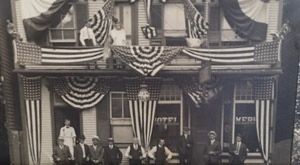 Diane found a newspaper
article from June 21, 1910 referring to Jacob Merkt's hotel on Walnut
Street; *possibly* he lived at or ran a hotel at 11 Walnut Street for a
time, although that's just a guess (there was a hotel at that address,
old address numbering system). Both Charlie and Diane found 1914-1915
references to Jacob Merkt in the Hazleton Plain Dealer and in the
Wilkes Barre Record as having a saloon on Front Street, at 16 Front St.
(old address numbering system) in 1914 and then at 723 Front St. (same
location, new numbering) in 1915. Perhaps he had a boarding house along
with his saloon and was turning it into a hotel. At least one of
Diane's newspaper finds referred to a hotel license application.
Diane found a newspaper
article from June 21, 1910 referring to Jacob Merkt's hotel on Walnut
Street; *possibly* he lived at or ran a hotel at 11 Walnut Street for a
time, although that's just a guess (there was a hotel at that address,
old address numbering system). Both Charlie and Diane found 1914-1915
references to Jacob Merkt in the Hazleton Plain Dealer and in the
Wilkes Barre Record as having a saloon on Front Street, at 16 Front St.
(old address numbering system) in 1914 and then at 723 Front St. (same
location, new numbering) in 1915. Perhaps he had a boarding house along
with his saloon and was turning it into a hotel. At least one of
Diane's newspaper finds referred to a hotel license application. 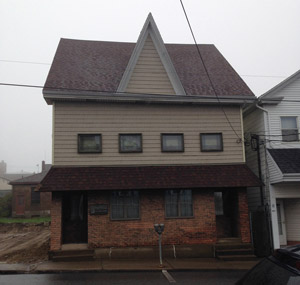

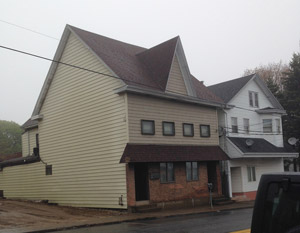 After looking around
town for a similar building, Charlie wrote: "...
that building between the newly emptied lot and what was Sharp's sure
does look a lot like the building in the Hotel Merkt photo. I'm looking
at the Sanborn maps. 1900, 1905, 1912 all show a dwelling on the left
side of that 2-story building and a saloon on the right side. 1895
shows a dwelling on the left side, right side unlabeled. 1923, dwelling
on left side and business of some kind on right side."
After looking around
town for a similar building, Charlie wrote: "...
that building between the newly emptied lot and what was Sharp's sure
does look a lot like the building in the Hotel Merkt photo. I'm looking
at the Sanborn maps. 1900, 1905, 1912 all show a dwelling on the left
side of that 2-story building and a saloon on the right side. 1895
shows a dwelling on the left side, right side unlabeled. 1923, dwelling
on left side and business of some kind on right side."The outcome of all of this research and speculation is that it seems likely that the Merkt Hotel was in the building at 723-725 Front Street, shown in these photos that Charlie took last year during a demolition. Thanks, Charlie!
And, Diane found this article, which gives us some interesting background on Jacob's brother, Michael Merkt:
------
Plain Speaker - August 8, 1936 - Will Leave For Virginia
Michael Merkt, of Freeland, better known as "Charley" Merkt will leave next Tuesday for Bedford, Virginia, to take up his residence at the Elks Home there. Mr. Merkt is a retired Freeland merchant and for many years was an outstanding figure in Freeland's business activities. For many years he operated an ice cream parlor here which was the center of the town's activities. He started the first bus lines in this region, operating a service to White Haven, founded the first taxi service in Freeland and was the first wholesale confectioner in the region. He operated an ice cream and candy manufacturing business for many years in addition to his other activities. ... A charter member of the Freeland Lodge of Elks, he was not only one of the most active members of the Lodge but was one of the men who helped found the Elks Club and was one of its most prominent members. Next Monday night, on the eve of his departure, the members of the Freeland Lodge will hold a farewell party to honor him for his work in building the Lodge and the Club to its present day status.
------
The photo at top of this page, upper left also shows a Merkt confectionery and ice cream store, about which see the note near bottom of page. Someone had commented to me that he also had one near Belezza's, but when I posted that Ed Merrick commented: "Merkt could have had an ice cream parlor near Bellezza’s, but, when I was a kid, Russell’s Ice Cream Parlor was in where Charlie’s Men’s Store eventually was located."
If I can ever get the various Merkt businesses sorted out, I'll make a page about them.
Freeland Overall Factory patent for trademark, plus a note on Thomas Oberrender, from Charlie Gallagher:
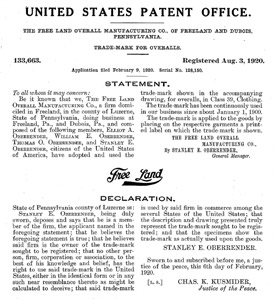 Here is the 1920 patent for the Free Land Overall
Manufacturing
Company's trademark. In it they note that the trademark "has been
continuously used in our business since about January 1, 1900."
Related
to this company, Charlie also shares a story about the son of one of
the Oberrender brothers who owned Freeland Overall. He writes:
Here is the 1920 patent for the Free Land Overall
Manufacturing
Company's trademark. In it they note that the trademark "has been
continuously used in our business since about January 1, 1900."
Related
to this company, Charlie also shares a story about the son of one of
the Oberrender brothers who owned Freeland Overall. He writes:"Of the four Oberrender Brothers that ran Free Land Overalls, William, Stanley & Elliot stayed in Freeland. Thomas went to DuBois to manage that factory that opened there in 1906. Thomas and Helena Graaf Oberrender also welcomed their son Thomas Olin Oberrender, Jr. on September 24, 1906 in DuBois. Thomas Jr. went on to the Naval Academy, graduating in 1927."
"Thomas Olin Oberrender, Jr., born in DuBois, Pa. on 24 September 1906, graduated from the Naval Academy in the Class of 1927. After serving in cruisers ROCHESTER, TULSA, and LOUISVILLE and other ships, he attended postgraduate school from 1934 to 1936, followed by duty in battleship NEVADA. Assigned as engineering officer in destroyer HULL in 1938, he became her executive officer the following year. After a brief period of duty ashore he reported on board the new cruiser JUNEAU in November 1941, when the ship was just fitting out. When she commissioned the following February, he was her engineering officer. Lt. Comdr. Oberrender died 13 November 1942 when JUNEAU was torpedoed and sunk in action in the Solomon Islands. USS Oberrender (DE 344) (1944-1945) was the first ship to be named in his honor. While it has nothing to do with Freeland history, if his father had remained in Freeland, perhaps Thomas Jr would have taken the same career path? Who knows..."
http://www.navsource.org/archives/06/344.htm (includes portrait of Thomas)
https://en.wikipedia.org/wiki/USS_Oberrender
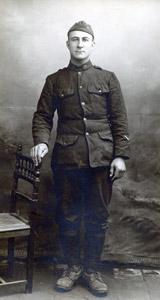
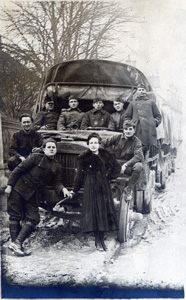 John Ricotta
during WWI, from Charlie Gallagher: These photos are of John
Ricotta of Freeland (he was Woodies waitress Carmelita Ricotta's uncle)
during World War I. One photo is a portrait; in the other he is shown
in France in 1918, second from the left sitting in the front seat of
the truck. Charlie wrote that "John apparently never married and
all of the Ricottas are now gone for the most part. ... John was like
one of the family to my great grandparents. He lived at 420 Adams St.
and they lived in the other half at 422 (1895-1922). When they moved to
507 Washington St. in 1923, the families stayed close. Those photos
were from letters that John sent to my great aunt Mary B. Gallagher."
John Ricotta
during WWI, from Charlie Gallagher: These photos are of John
Ricotta of Freeland (he was Woodies waitress Carmelita Ricotta's uncle)
during World War I. One photo is a portrait; in the other he is shown
in France in 1918, second from the left sitting in the front seat of
the truck. Charlie wrote that "John apparently never married and
all of the Ricottas are now gone for the most part. ... John was like
one of the family to my great grandparents. He lived at 420 Adams St.
and they lived in the other half at 422 (1895-1922). When they moved to
507 Washington St. in 1923, the families stayed close. Those photos
were from letters that John sent to my great aunt Mary B. Gallagher."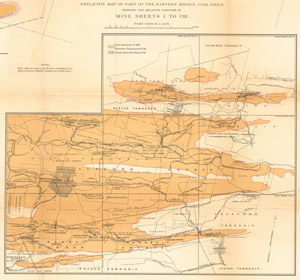 1888 map
of the coal fields in the Beaver Meadow and Druck Creek basins, from
Charlie Gallagher: Charlie shares this 1888 map of the Beaver
Meadow and Dreck Creek Basins of Luzerne and Carbon Counties, Eastern
Middle coal field mine sheet no. VI-2-AA, Atlas v. 2, plate 4.
1888 map
of the coal fields in the Beaver Meadow and Druck Creek basins, from
Charlie Gallagher: Charlie shares this 1888 map of the Beaver
Meadow and Dreck Creek Basins of Luzerne and Carbon Counties, Eastern
Middle coal field mine sheet no. VI-2-AA, Atlas v. 2, plate 4.Featured photos: Ridge street Opera house, contributed
by
Charlie Gallagher, with additional information from Brigid McMenamin,
posted 9-18-2016
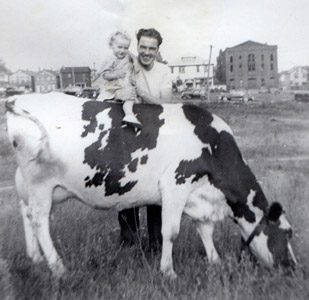 Charlie
Gallagher sent me a photo of relatives of his, photographed with a cow.
It was very exciting! They were standing in a clover field, and I
thought it was near where later the Clover Bar was built (and, I've
heard, named for the clover field). Many Freelanders in the old days
had livestock (cows, pigs, chickens, etc.) and in the case of the cows
they needed to be able to bring them to temporary pasture somewhere.
The open field at Ridge and Luzerne streets was a popular spot for this
purpose, and in this photo you see one of the local cows, photographed
with Charlie's relatives. However, he emailed me back to offer a
correction to what I'd written there: "My Pop (Bernie Jr.)
holding my sister Sheila on the back of the cow. They would have been
standing near the south end of St. John's parking lot on Vine Street.
(Notice the cars in the background are on Fern St, not Ridge St.)"
Charlie
Gallagher sent me a photo of relatives of his, photographed with a cow.
It was very exciting! They were standing in a clover field, and I
thought it was near where later the Clover Bar was built (and, I've
heard, named for the clover field). Many Freelanders in the old days
had livestock (cows, pigs, chickens, etc.) and in the case of the cows
they needed to be able to bring them to temporary pasture somewhere.
The open field at Ridge and Luzerne streets was a popular spot for this
purpose, and in this photo you see one of the local cows, photographed
with Charlie's relatives. However, he emailed me back to offer a
correction to what I'd written there: "My Pop (Bernie Jr.)
holding my sister Sheila on the back of the cow. They would have been
standing near the south end of St. John's parking lot on Vine Street.
(Notice the cars in the background are on Fern St, not Ridge St.)"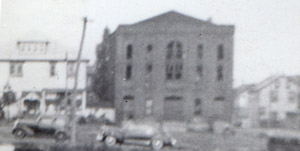 Ok, so there was more open land there in 1941 than I'd
thought! But it wasn't just actually seeing a cow in what I thought was
the legendary Clover Bar clover field that was exciting, although that
was pretty cool -- it was also the buildings in the background. The
large building is one of John Yannes's two opera houses (the other one
was at Front and Washington streets), and although the photo is blurry
you can get some idea of what that building looked like before it
became a silk mill and later was turned into apartments for senior
citizens.
Ok, so there was more open land there in 1941 than I'd
thought! But it wasn't just actually seeing a cow in what I thought was
the legendary Clover Bar clover field that was exciting, although that
was pretty cool -- it was also the buildings in the background. The
large building is one of John Yannes's two opera houses (the other one
was at Front and Washington streets), and although the photo is blurry
you can get some idea of what that building looked like before it
became a silk mill and later was turned into apartments for senior
citizens. 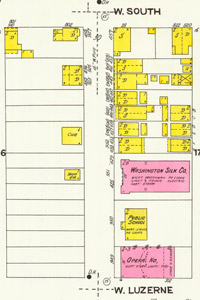

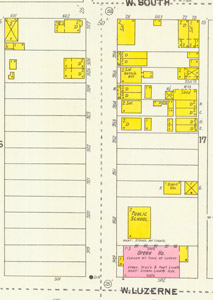 The building next
to it had once been one of the small public schools (see Freeland schools in 1912 for the
others), later Belekanich's beer distributorship, bar and restaurant.
Both buildings are still there. Charlie's photo was from 1941. The map
details shown here are earlier (left 1905, right 1923), but the maps
and 1941 photo show that for quite some time much of the west side of
that block of Ridge street remained undeveloped. Although you see that
in 1923 the Band Room was already there!
The building next
to it had once been one of the small public schools (see Freeland schools in 1912 for the
others), later Belekanich's beer distributorship, bar and restaurant.
Both buildings are still there. Charlie's photo was from 1941. The map
details shown here are earlier (left 1905, right 1923), but the maps
and 1941 photo show that for quite some time much of the west side of
that block of Ridge street remained undeveloped. Although you see that
in 1923 the Band Room was already there!More about the Opera House
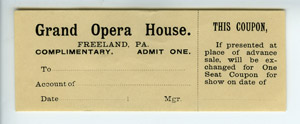

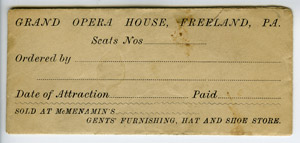
These two items also come from Charlie. John McMenamin's men's clothing store was on Centre street, two buildings down from O'Donnell's livery in the middle of the block between Luzerne and South streets. By 1923 the building number was 438 (earlier it had been 86 S. Centre, then 113 S. Centre - you see on the map details below how the previous number is in parentheses next to the new number for each building, as the address numbering was redone several times in town and the maps had to keep up). The Ridge street opera house was just a block or so away. Here we have a complimentary ticket to the Grand Opera House, along with the envelope that it or paid opera house tickets would be placed in. So McMenamin's store was one business where one could get tickets to shows. In the 1917 Scranton phone directory, which included other area towns, John McMenamin is listed at 436 Centre street as "Mgr. of Opera House." In the 1921 city directory, at 436 Centre the "men's furnishings" store was now being run by Bernard Boyle.
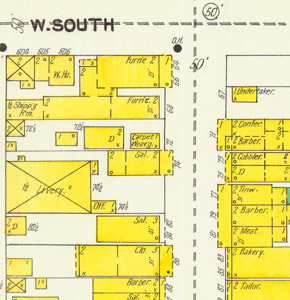

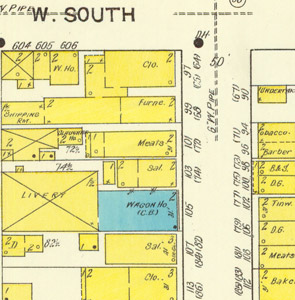

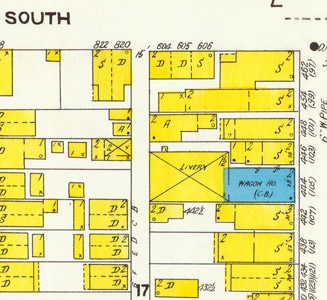
Awhile ago Brigid McMenamin sent some information to add to the Baseball page, writing: "I just noticed that in your 1903 photo of the Freeland Tigers the guy in the middle (jacket, tie, full head of dark hair) looks just like Hugh A. McMenamin (1878-1943) of Centre Street, who graduated from MMI, St. Michaels (Toronto) and Philadelphia Dental School 1907 and went on to practice in Scranton. I know he was associated with the [Freeland Tigers] team, which I believe was cofounded by his brother John J. (1872-1917), who also managed the Opera House, founded a men's shop on Centre, and co-founded the Ferry drugstore, and built a big house on Vine for his wife Margaret (Maggie Ferry, sister of Fanny & daughter of Freeland saloonkeepers/ hoteliers Maurice & Mary (McGinley) Ferry) and their 11 children."
In a follow up message, she added: "This is definitely a photo of Hugh A. McMenamin. Perhaps he was between college and dental school. I do know that John had been President of the Tigers club but by this time he was busy with a growing family, managing the Grand Opera, selling tickets out of his Centre Street haberdashery, and had just co-founded the bank. As for the Ferrys, I believe that what they called a hotel was really the saloon, though perhaps they also offered food and rooms. I'm guessing it was on the corner of South & Washington closest to 517 Centre, as that's where Fanny lived in the 60's. Whatever it was, it must have been a success, as the Ferrys led fairly comfortable lives, and were able to provide their children with music lessons, education in Toronto, and pleasure trips to Montana and even Ireland in 1897."
[In case you are rereading this section, I had earlier included here some listings of McMenamins and Ferrys from early Freeland directories, but I've removed them to use on another page about these businesses later.]
Thank you, Charlie, and thank you, Brigid for these featured photos and information that I'm posting here today. Great stuff!
P.S. Just as a matter of interest, here are previous occupants/listings possibly in that building at 438 Centre before John McMenamin was there (I say possibly because sometimes these published listings are wrong):
Grocery at 86 S. Centre (1895 Sanborn map)
Gillespie & Curry (John Gillespie and E. J. Curry), grocers (1897 city dir.)
Andrew Polesa’s saloon (1897 city dir.)
Gillespie & Curry (John Gillespie and E. J. Curry), grocers (1901-1902 city dir.)
Curry, E. J., dry goods and groceries, 91 Centre! (did they move?-CT) (1901-1902 city dir.)
Andrew Polesa’s saloon (1901-1902 city dir.)
Dry goods at 86 S. Centre (1900 Sanborn map)
Clothier (1905 Sanborn map)
McMenamin, J. J., gent's furnishers., etc., 86 Centre (1901-1902 city dir.)
Clothing - 113, formerly 86 (1912 Sanborn map)
Featured photos for Christmas 2015, posted December 25,
2015:
A Christmas play, in Freeland or the Freeland area
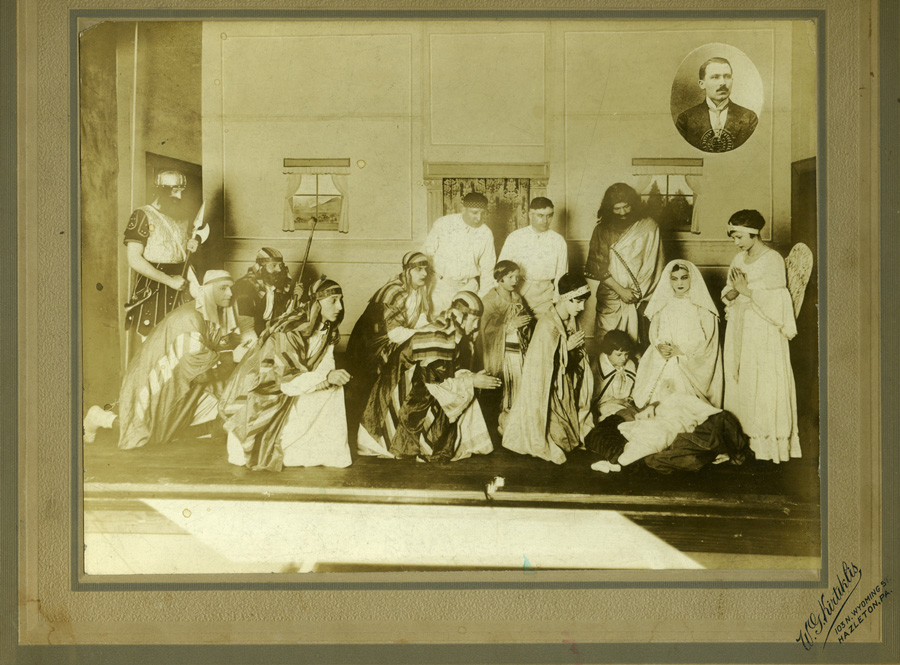
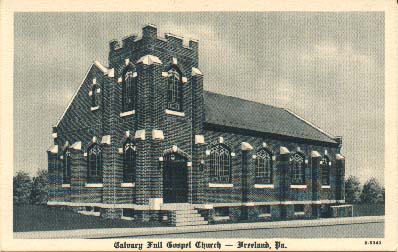
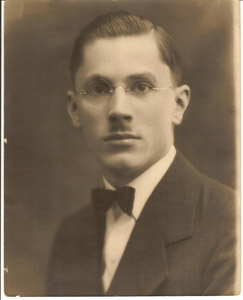 At
present I'm not able to put my hands on documentation about this photo,
but I wanted to post it anyway as a look at a common practice in some
of Freeland's churches in the past. I have to say that the portrait in
the upper right corner looks very much like Reverend John Grayson
Jones, pastor of the New Calvary Pentecostal Church, now home to the
Freeland branch of the Hazleton Area Public Library. Or, perhaps that's
just a superficial resemblance. The more I look at the two portraits,
the more I think that might be someone else. I'll look into this
further at some point, but meanwhile please enjoy the photo of the
participants in a Christmas play in our area, many years ago.
At
present I'm not able to put my hands on documentation about this photo,
but I wanted to post it anyway as a look at a common practice in some
of Freeland's churches in the past. I have to say that the portrait in
the upper right corner looks very much like Reverend John Grayson
Jones, pastor of the New Calvary Pentecostal Church, now home to the
Freeland branch of the Hazleton Area Public Library. Or, perhaps that's
just a superficial resemblance. The more I look at the two portraits,
the more I think that might be someone else. I'll look into this
further at some point, but meanwhile please enjoy the photo of the
participants in a Christmas play in our area, many years ago.Featured photos: Pal Whitehead died on Christmas eve,
2014, posted January 2, 2015
Because Pal played such an important role in Freeland in
so
many ways, and because he touched so many of us with his warmth, humor
and generosity, I wanted to post the news of his passing especially for
out-of-town readers, and share these photos from Ed Merrick and Charlie
Gallagher.Here's a link to his obituary in the Standard Speaker.
This beautiful photo comes from Ed Merrick, taken in front of Woodie’s on February 23, 1987.
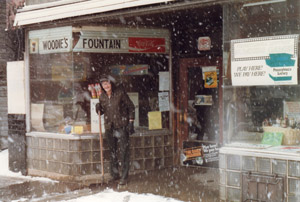
Charlie Gallagher shares this picture of Pal when he was Fire Chief in the 1976 Centennial Parade.
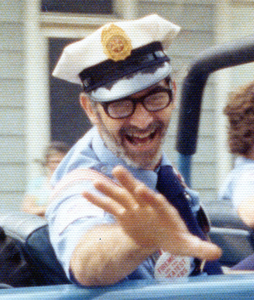
And here are some more photos from Ed Merrick, showing Pal and others enjoying pickup football games in the mid-1960s. Ed took the leftmost photo at a football game on September 6, 1964 at the Tigers Park, "or MMI Field as it has come to be known. Pal was coach of Woodie's Raiders, who lost to Smokey's Bears 18-0." I asked him if he could tell me more about these games at Tigers Park. He wrote:
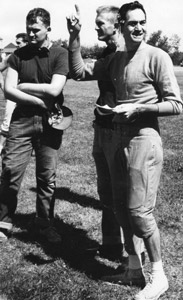
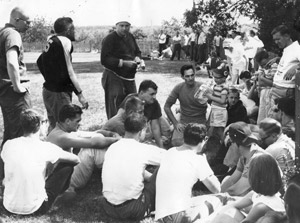
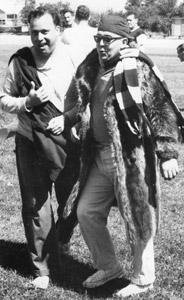 They were pickup
teams. The manager of the Bears was Jim Quinn, whom I do not know. He
was probably a guy who came in for a cup of coffee, started talking to
Pal, and challenged him to get a team together and play. We had no
helmets and pads; we didn't even have goal posts, hence the score. Tom
Zubatch published a bunch of the photos in his Pennysaver, and I wrote
a funny article to go with them.
They were pickup
teams. The manager of the Bears was Jim Quinn, whom I do not know. He
was probably a guy who came in for a cup of coffee, started talking to
Pal, and challenged him to get a team together and play. We had no
helmets and pads; we didn't even have goal posts, hence the score. Tom
Zubatch published a bunch of the photos in his Pennysaver, and I wrote
a funny article to go with them.For your information, [the photo at right] shows Don Snyder and Jack Timony, girded for battle; [in the center photo], Pal in center seated; standing, Carl Poppolardo, your neighbor; a fellow who is familiar but whose name I can't come up with; Don Snyder in white hat; and Ed Herbener, with his arms over a fence at right; I can't remember the name of the fellow in the middle. A fourth photo from Ed shows this great action shot!

Mystery solved! Update
to
Featured photos: Mines and quarries - Thinking about the Post Office
mural, posted June 29, 2014 (full post a few posts below, dated June
29, 2014, so after reading this, you can scroll down to see the earlier
post)
At the end of his Featured photos post on my home page
in
August 2014, former Highlander Tom Yaruso made this comment about the
question of which breaker is shown in the mural that's on the wall in
the Freeland Post Office: I remember my grandpa, Peter Martonis from Highland who worked underground at Markle Coal Company # 2 at base of Highland Eckley mountain, told me that breaker on the Post Office mural is # 2 where he worked from 1906 till I think 1939. We lived with him in Highland. It can’t be Drifton breaker as no mountain was in back of Drifton breaker.
More recently, I was in touch with Charlie Gallagher, who is inclined to agree. He wrote:
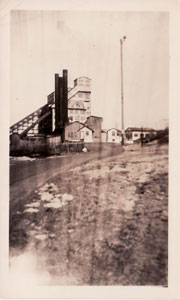 Your recent collaborator, Mr. Yaruso
gives a compelling argument the the breaker is the Highland
breaker. This makes sense to me, if the Highland breaker was around in
the fall of 1937 and winter of 1938. If that is the case, then Mr.
Follinsbee's related work "Freeland
Your recent collaborator, Mr. Yaruso
gives a compelling argument the the breaker is the Highland
breaker. This makes sense to me, if the Highland breaker was around in
the fall of 1937 and winter of 1938. If that is the case, then Mr.
Follinsbee's related work "FreelandCoalbreaker, West Pennsylvania" is actually the Highland Breaker and some of the Highland houses. (where he got West Pennsylvania from [for the label] is anyone's guess!)
Also, did you notice that the pencil Freeland study has a dog and a person walking just in front of the dump truck and the Freeland study in paint has two people walking in front of the dump truck that does not appear in the post office.
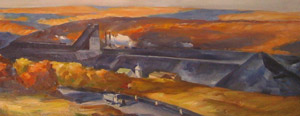 I was skeptical, largely because other Highland
breaker images in my files don't look anything like that breaker in the
mural. My brother Steve wondered whether it was the Drifton breaker,
viewed through binoculars and brought forward in the painting. Reading
Tom and Charlie's more recent comments, I realized that those
images I'd been looking at were all of Highand breaker no. 5, and so
after further digging I found a photo of Highland breaker no. 2,
provided courtesy of the Freeland Historical Society. Take a look!
I was skeptical, largely because other Highland
breaker images in my files don't look anything like that breaker in the
mural. My brother Steve wondered whether it was the Drifton breaker,
viewed through binoculars and brought forward in the painting. Reading
Tom and Charlie's more recent comments, I realized that those
images I'd been looking at were all of Highand breaker no. 5, and so
after further digging I found a photo of Highland breaker no. 2,
provided courtesy of the Freeland Historical Society. Take a look!And now Ed Merrick has written this:
In the October 1993 edition of a publication called Panorama, which was sent to me by my sister, Part 28 of Charles Stumpf's
"Reflections: A Mini History of Freeland" has this to say about the Post Office mural:
In 1934 the Federal Works Progress Administration (better known as the WPA) hired artists to paint murals for federal buildings. The new Freeland post office was selected as one of the sites for such a mural. Artist John Folinsbee was commissioned in October 1937 to paint the mural, measuring 13 feet 11 inches long, and 5 feet 3 inches high. Shown in the left half of the painting are the twin domes of St. Mary's Byzantine Catholic Church as well as the roof of the Freeland Brewery, and one of the spires of St. John's Roman Catholic Church. On the right, the Highland No. 2 Breaker and a slate bank at Drifton, as well as MMI are partially visible. The mural hangs in its original position directly above the door to the postmaster's office, in the east wall. It extends the entire length of the lobby. The artist was paid $610 for his work.
So there we are! Thanks to Tom, Charlie Gallagher, Steve, Ed Merrick, the late Charlie Stumpf, and the Freeland Historical Society for helping to figure this out.
Featured photos: Mines and quarries - Thinking about the Post Office mural, posted June 29, 2014
 This is a long, rambling vine of a posting. This past fall
and winter I had a number of conversations (in person, on the phone,
and by email) directly or indirectly about the view shown in the post
office mural, and about the quarry that was the source of the stones
used in St. John’s Nepomucene Roman Catholic and St. Luke’s Lutheran
churches. My fellow conversationalists included Charlie Gallagher, Bob
Zimmerman, my brother Steve, and Antoinette Ranieri Refowich. Today I’m
taking the opportunity to share what I learned from them. Maybe someone
reading this can contribute more.
This is a long, rambling vine of a posting. This past fall
and winter I had a number of conversations (in person, on the phone,
and by email) directly or indirectly about the view shown in the post
office mural, and about the quarry that was the source of the stones
used in St. John’s Nepomucene Roman Catholic and St. Luke’s Lutheran
churches. My fellow conversationalists included Charlie Gallagher, Bob
Zimmerman, my brother Steve, and Antoinette Ranieri Refowich. Today I’m
taking the opportunity to share what I learned from them. Maybe someone
reading this can contribute more.My brother Steve and I were talking about the post office mural one day last fall, wondering where the artist John Follinsbee was looking from when he made the sketches for the Freeland mural in the late 1930s. Somewhere up on Butler Terrace, but where? Some people have suggested that what he drew was a stylized view that didn’t directly copy what he saw. For a long time I thought that myself. But, it seemed worth having another look.
The three buildings highlighted in the mural are, left to right, St. Mary’s, the Freeland Brewery, and St. John’s Nepomucene. Further to the right is an unnamed colliery. Maybe it was supposed to be the Drifton colliery, just not shown exactly where it really was (because would he have been able to see it from where he was sitting or standing?). Artistic license, perhaps. On a side note, it’s interesting that the logo created for Freeland
 seems to feature the same two churches (out of 13 in town at
the time), but as seen from the other direction. Charlie Gallagher
tells me that the design was created by Victor Poleri, citing a 1993 newspaper
clipping, which includes this note: “The Freeland Chamber of
Commerce announced its appreciation to Victor Poleri for the
painstaking effort he put into the design and installation of the
attractive welcoming signs at the main highway entrances to Freeland.
Poleri, the chamber said, is responsible for the innovative way of
presenting Freeland as Pennsylvania's highest borough by depicting the
community's skyline in silhouette.”
seems to feature the same two churches (out of 13 in town at
the time), but as seen from the other direction. Charlie Gallagher
tells me that the design was created by Victor Poleri, citing a 1993 newspaper
clipping, which includes this note: “The Freeland Chamber of
Commerce announced its appreciation to Victor Poleri for the
painstaking effort he put into the design and installation of the
attractive welcoming signs at the main highway entrances to Freeland.
Poleri, the chamber said, is responsible for the innovative way of
presenting Freeland as Pennsylvania's highest borough by depicting the
community's skyline in silhouette.”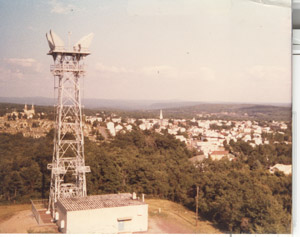 Meanwhile,
my brother turned up this photo that he took around 1980, he thinks
from the fire tower. Well, this was interesting. If you look at the
enlarged cropped section shown at right below, the street visible to
the right of the tower looks like Main Street, and would have led to
within a half block of the brewery when it was still standing, putting
it right where it is in the mural, between the two churches. So that
seeming exact match made me wonder if perhaps there was actually a
colliery somewhere there where one is shown in the mural.
Meanwhile,
my brother turned up this photo that he took around 1980, he thinks
from the fire tower. Well, this was interesting. If you look at the
enlarged cropped section shown at right below, the street visible to
the right of the tower looks like Main Street, and would have led to
within a half block of the brewery when it was still standing, putting
it right where it is in the mural, between the two churches. So that
seeming exact match made me wonder if perhaps there was actually a
colliery somewhere there where one is shown in the mural. 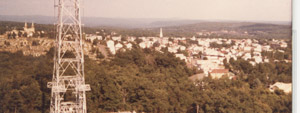 Where
exactly IS the spot in Freeland where Follinsbee shows a mining
operation in his mural? And was he up in the fire tower seeing this
view, or was he somewhere else? We know that the fire tower was
actively used as a lookout point for spotting fires in the late 1930s;
in 1939 Freeland’s fire tower watcher Louis
Corazza was quoted talking about how bad the fires were due to
extraordinarily dry conditions (thanks to Steve Tancin for that link).
So Follinsbee could have been up there; if so, what would he have been
able to see? And if that’s not where he was sketching from, I wonder
where he was?
Where
exactly IS the spot in Freeland where Follinsbee shows a mining
operation in his mural? And was he up in the fire tower seeing this
view, or was he somewhere else? We know that the fire tower was
actively used as a lookout point for spotting fires in the late 1930s;
in 1939 Freeland’s fire tower watcher Louis
Corazza was quoted talking about how bad the fires were due to
extraordinarily dry conditions (thanks to Steve Tancin for that link).
So Follinsbee could have been up there; if so, what would he have been
able to see? And if that’s not where he was sketching from, I wonder
where he was?On the website for Follinsbee’s work, there is a page about the Freeland mural and it includes this paragraph: “Folinsbee completed his mural on 9 March 1938, and it was installed two months later. His description, as submitted to the Section of Fine Arts, reads: ‘This mural depicts a view of Freeland from Butler Terrace. Familiar buildings of the town may be seen at the left. In the central section are the mine and large breaker. In the right foreground is the Drifton State Bank, a landmark of the vicinity.’ Folinsbee was so interested in this coal breaker that three years later he made it the subject of a large painting, Freeland Coal Breaker.”
 Questions:
Questions:1. Surely he meant to say “Drifton slate bank”?
2. What coal breaker is being referred to as the Freeland Coal Breaker?
3. Does the note about the Drifton slate bank mean that this was the Drifton colliery being depicted?
4. Could he see it from Butler Terrace?
For awhile I thought that this might have been the old Woodside colliery, but Charlie Gallagher says no, and in 1893 Bradsby wrote: "The old Woodside slope was once an active colliery but is not worked at this time. It is a short distance west of Freeland borough and toward Drifton."
The Freeland Stone Quarry
Meanwhile, around the same time that these conversations were taking place, I was also talking with my old high school classmate Harold Refowich’s wife Antoinette, whose great-grandfather Joseph Ranieri built new stone churches for both St. John’s Nepomucene Roman Catholic and St. Luke’s Lutheran parishes. Not only did he and some of his compatriots from Italy build those churches, but they actually first quarried the stones themselves locally.
Antoinette has kindly shared information about Joe Ranieri and his family, as well as two photos. Giuseppe (Big Joe) and Elisabetha (Scarfone) Ranieri came to the U.S. from the town of Borgia, in the Calabria region of Italy. They had 8 children:
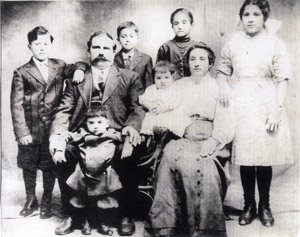
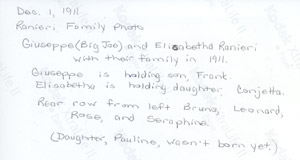 -
Seraphine (Procopio)
-
Seraphine (Procopio)- Bruno
- Rose (Poleri)
- Leonard
- Conjetta (died in infancy)
- Frank
- Conjetta (Senape)
- Pauline (Franklin)
When this wonderful family photo at right was made, Pauline wasn’t born yet.
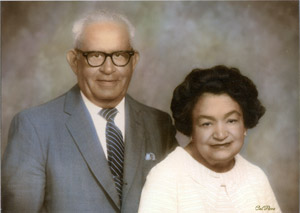 In
1914 Big Joe Ranieri encouraged his stonemason friend in Italy,
Raffaele Pulera (Poleri), along with Raffaele's son Vito, to come to
Freeland to help build St. John’s Nepomucene Church. Another paesano
who came to Freeland from the same region was Salvatore (Jimmy)
Procopio. Both Vito Poleri and Jimmy Procopio married daughters of Big
Joe and Elisabetha, Vito marrying Rose (at left) and Jimmy marrying
Seraphine. They worked with their father-in-law at the quarry and on
his building projects. It was Joe Ranieri who founded the quarry from
which the stones came that were used to build St. John's, St. Luke's,
and also the grocery store on Main and Ridge streets that he ran with
his wife. The Procopios had a bar just a little way down the block from
the Ranieri’s grocery store on Ridge Street.
In
1914 Big Joe Ranieri encouraged his stonemason friend in Italy,
Raffaele Pulera (Poleri), along with Raffaele's son Vito, to come to
Freeland to help build St. John’s Nepomucene Church. Another paesano
who came to Freeland from the same region was Salvatore (Jimmy)
Procopio. Both Vito Poleri and Jimmy Procopio married daughters of Big
Joe and Elisabetha, Vito marrying Rose (at left) and Jimmy marrying
Seraphine. They worked with their father-in-law at the quarry and on
his building projects. It was Joe Ranieri who founded the quarry from
which the stones came that were used to build St. John's, St. Luke's,
and also the grocery store on Main and Ridge streets that he ran with
his wife. The Procopios had a bar just a little way down the block from
the Ranieri’s grocery store on Ridge Street.Charlie Reczkowski had told me several years ago about Mr. Ranieri building the churches, adding that Mr. Ranieri previously owned the site of the Corner Store and had himself built the foundation and store using that same quarried stone. There had been a grocery store on that site at Main and Ridge streets as early as 1895 (see 1895 map detail below), but in the 1920s Mr. Ranieri built a new building there that still stands today. He and his wife Elisabetha ran a grocery store there, later taken over by Billy Nitka (one of several stores he had over the years), and then later taken over in turn by the Reczkowskis and only closed fairly recently. What a wonderful long run that site had as a grocery store of one kind or another, for more than a century.
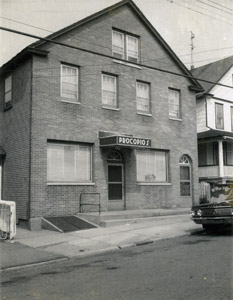

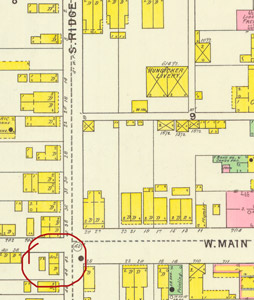

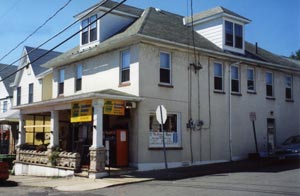
Antoinette offered to ask her uncle Bill where the quarry was, and he told her that it was “out by the Wooden Nickel.” He says that the quarry founded by Joe Ranieri was on Green Street (south of South Street), second from the last property on Green Street, next to where Antoinette's grandfather Vito Poleri had his shop. The property next to that belonged to the Citro family.
I do realize that there is probably no connection between the quarry and the colliery in the mural, but these were parallel queries as I was digging for possibilities, and somehow it seemed remotely possible that these properties might have been in the same general vicinity. Or not. It does also seem possible that one might have been able to see the area where the quarry was from the fire tower, although perhaps not the actual quarry itself.
On another side note, if you’re in Freeland, go and take a fresh look at St. John’s Nepomucene (while it's still there) and St. Luke’s churches. The stones and the stonework are really beautiful. Think about these strong and wonderfully skilled men cutting the stones out of the ground, shaping them, fitting them together to create these gorgeous buildings. What talent, what skill, what incredible ability they applied to this extraordinary undertaking. I have great admiration for these and other stonemasons who helped to build Freeland. The original St. Luke’s was made of wood and built in 1876-1877; the cornerstone for the new stone church was laid in 1924. The original St. John’s Roman Catholic church was also a wooden building on the corner of Ridge and Luzerne, cornerstone laid in 1892, dedicated in 1893, and the new cornerstone is dated 1915. Both of these early wooden churches, one German and the other Slovak, were replaced with larger, more solid and more complex stone buildings, built by these Italian stonemasons. St. John's new church was built a few blocks away from the old one.
Just to share a few more connections that surfaced through the emails, Bob Zimmerman noted that “Mrs. Procopio, of the bar on Ridge St. a few doors south from the Corner Store, was a Ranieri. Her daughter, Elizabeth Procopio, was my Spanish teacher in high school. … I remember her saying that her grandfather built the Lutheran Church with stone quarried somewhere near that site at the bottom end of Green St. which we always called St. Ann's. One of Betty's brothers was called ‘Deitz.’ It was his job to put out lanterns at construction sites where his grandfather worked. The manufacturer of the lamps was "Dietz". It has been years since I have seen Betty. The last time I visited her was several years ago at her home near Danville. We put together an art show at Eckley featuring local artists. I borrowed some of Vic Poleri's water colors from Betty and from her niece.”
[I'll add from my conversation with Antoinette Refowich that apparently a number of Vic Poleri's paintings of Freeland churches are now at Our Lady of the Immaculate Conception church.]
Charlie Gallagher wrote: “I knew Vito Poleri and his son Ralph well. They had Poleri Construction on Ridge Street next to the Clover Bar. I did a lot of drafting work for Ralph when I was at Penn State and just afterwards. I did the preliminary drawings for the Refowich when AMBART Realty bought it in the 70's. AMBART stood for Ann Maryann Bernie Amy Rosemary Tara. AMBART was owned by Ralph Poleri, Edward Herbener (by the way, my best man) and James Senape. Ann was Ralph's wife, Maryann was Eddie's, Bernie was Jimmy's. Amy was Eddie's daughter, Rosemary was Ralph's and Tara was Jimmy's. They were going to convert the Refowich to apartments and offices. You may recall that Jimmy Senape’s offices were there for a short time when he first set up his practice after leaving Martin O'Donnell. Then they sold it to Freeland Associates and it became the Freeland Senior Apartments. Many of the building trades were Italian in the Freeland Area: Poleri, DeFeo, Deitos, Pignatari, Marchetti (plumber and there was also a mason). I also remember Bruno Ranieri, but all I can recall is that he was retired. But for some reason, and I don't know why, I seem to recall an office on Main Street between Centre and Ridge Streets with Ranieri on the door. (Jack Della Croce and I would go up there to see his Grandmother Della Croce when we were kids.) (By the way, speaking of the Della Croces, where the Della Croce house is at 436 Washington Street was the site of the former Washington Street School.)”
Whew. So what have we learned here today, besides the notion that everything is connected to everything else? Seems like a lot, although not necessarily any answer to the question of the identity/location of the colliery shown in the post office mural. But this shows how fascinating it can be to pull a loose thread and not know what will come with it. My gratitude goes out to all who have shared photos, information and speculations with me. I will try to share more of this, as I receive additional input, so please send your ideas regarding that colliery. Thanks to all!
Click here to see earlier past featured photos.
Note: Photo at top left comes Pat Miller.